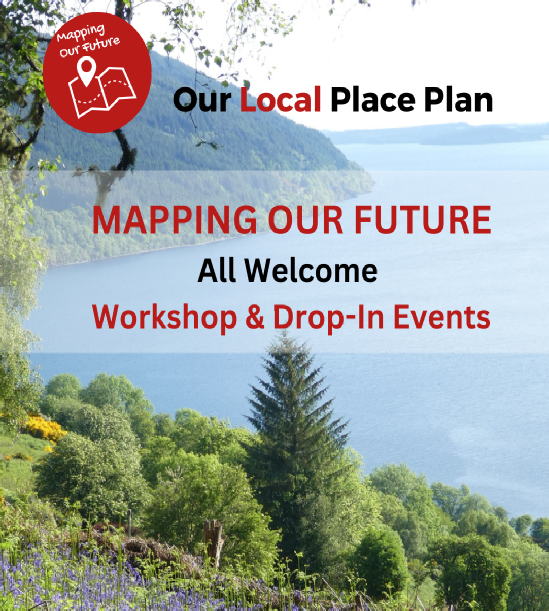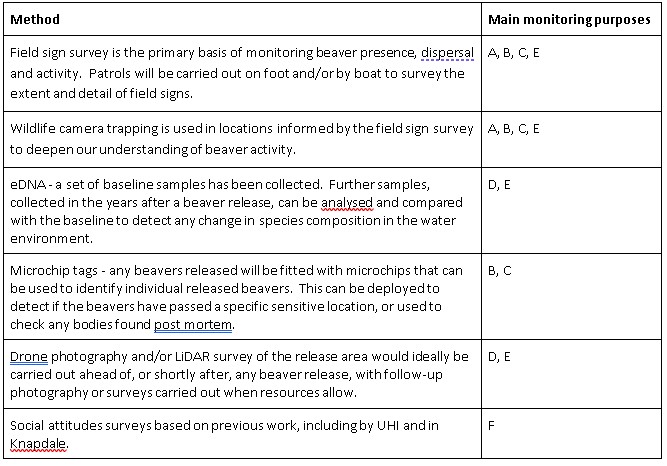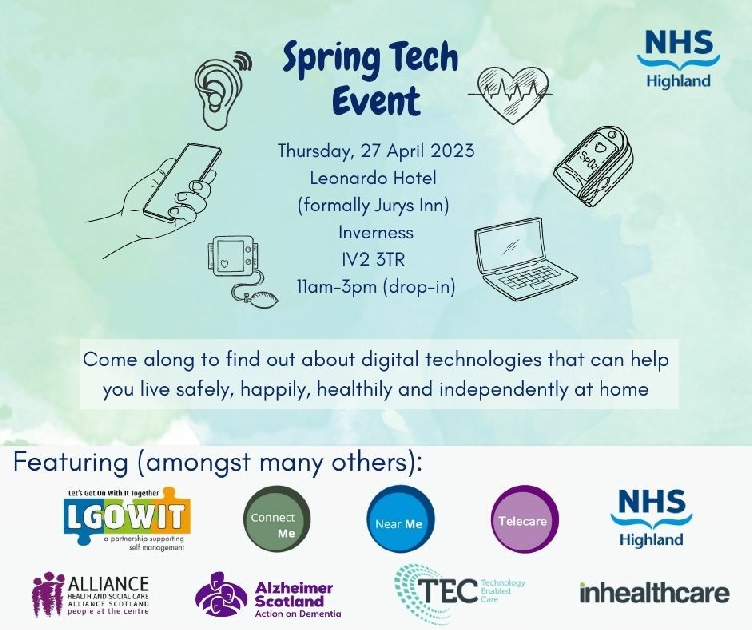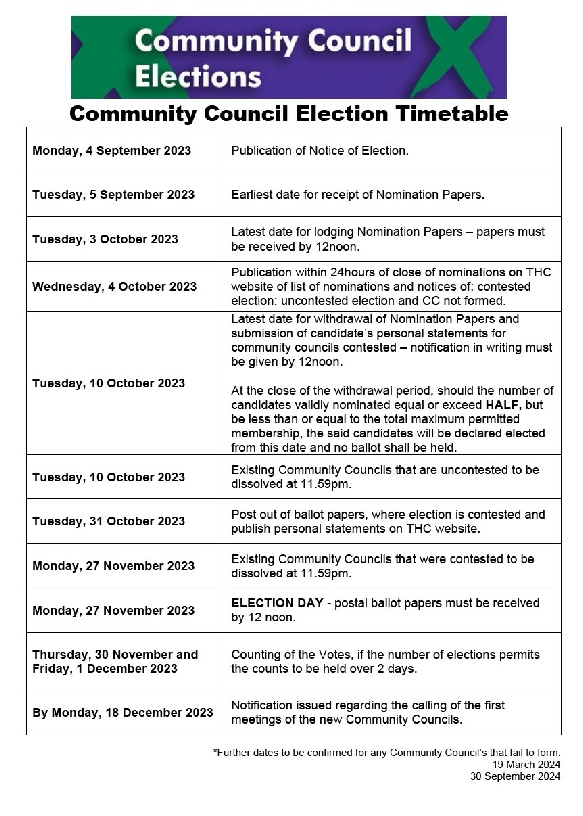

Glen Urquhart Community Council
Thursday 29th May 2025
GLEN EARRACH PUMPED STORAGE -
Glen Urquhart Community Council are holding an open public meeting to discuss the proposed plans for the Glen Earrach Pumped Storage scheme at Craigmonie Centre, Drumnadrochit -
Aim of this session is to collate community input to support Glen Urquhart Community Councils response to the Glen Earrach planning application. Details of the planning application are available https://www.glenearrach.energy/planning-
This is an open community event -
This application will be decided by the Scottish Government Energy Consents Unit. Any additional individual submissions can be made via Energy Consents Unit https://www.energyconsents.scot/Default.aspx -
GUCC acknowledge the short time frame for collating responses and that not all will be able to attend this meeting. We have also developed an online forms to assist in collating input. Link noted below.
https://forms.gle/B1xT8Rm8rtnNuBZq9
Thank you for your input and your voice
Wednesday 7th May 2025
Are you an Unpaid Carer living in Highland with a Disability or Long-
Click this link to access the questionnaire https://forms.office.com/pages/responsepage.aspx?id=1LdnYJsw-
Friday 2nd August 2024
Local Place Plan draft copy is now available
For more details go to our dedicated LPP website page http://www.glenurquhartcommunitycouncil.org.uk/localplaceplan.html
Wednesday 29th May 2024

Join us on Monday or Tuesday to help us map out the future of Glen Urquhart. All welcome.
A Local Place Plan is being prepared for Glen Urquhart. This is an opportunity for local people to comment on future development, changes and activities in the area.
It will feed into the Highland Council’s Local Develop Plan, showing our priorities for future development in the area, as well as helping us develop and deliver our own projects.
Workshop at Blairbeg Hall, Drumnadrochit on Mon 3 June, 6 -
Drop-
Have you filled in the survey for your chance to win a £100 voucher? It only takes a few minutes www.surveymonkey.com/r/GlenUrquhartLPP
Have your say in the development of your local area.
For more information: http://www.glenurquhartcommunitycouncil.org.uk/localplaceplan.html
Tuesday 26th March 2024
Craigmonie Woodland Association & Glenurquhart
Community Council
Community Tree and Shrub Planting Saturday 6th April
2024 10am – 1pm. In the parkland opposite Lewiston
Garage, Drumnadrochit.
Families and Individuals are invited to come along and plant a tree with the Woodland Group on
Saturday 6th April . We will be there from 10am to 1pm to help you plant trees and explain what we
are doing in your village. It’s an opportunity to take part in improving the environment in the village
It is also an opportunity to put forward ideas for the future. The trees we have at present were
donated by The Conservation Volunteer’s I Dig Trees Programme and we are asking for
donations to help them keep up supplying trees to communities around the country please come
along and we will help you plant a tree and donate whatever amount you think appropriate.
Burgers and Hot Dogs will also be on sale from 11am. Come along and join us on the 6th of April.
We have planted over 6,500 trees and shrubs in the Walks around Craigmonie Woods and the village
over the past 2-

Saturday 17th Feb 2024
Affric and Loch Ness National Park proposal update
Strathglass Community Council and it's partners have confirmed they will not be progressing with nomination for National Park for Affric and Loch Ness National Park.
Outcome of Initial Consultation Report link https://www.newnationalpark.org/initial-
Friday 19th January 2024
Inverness, Badenoch & Strathspey Citizens Advice Bureau
Inverness, Badenoch & Strathspey Citizens Advice Bureau are currently highlighting the need for more volunteer advisers. If you would like more information on becoming a volunteer adviser you can get more details at https://www.invernesscab.org/

Saturday 2nd December 2023
Bunloit Estate Highland Rewilding update
A Presentation from Calum Brown, Co-

Tuesday 22nd Nov 2023
Inverness Community Partnership meeting being held on Thursday 30 November 2023 at 6pm at UHI House, Inverness, IV2 3JH
For pdf containing further details please click here
Thursday 12th October 2023
Glen Affric Beaver Proposal Update from Forest Land Scotland (FLS)
As you will know, Forestry and Land Scotland has been working with Trees for Life to share information, discuss, and explore the potential to bring beavers back to this area for a little over a year now. This update summarises the work to date, how the proposal has evolved and further steps that will be taken ahead of submitting a licence application to NatureScot in time for beavers to be released to Glen Affric in the first few months of next year.
If the proposal is approved by NatureScot, it will be supported on an ongoing basis by a Trees for Life Species Management Officer who will provide boots on the ground to monitor beavers, stay in contact with the community, especially land managers and to complement NatureScot’s resources in implementing beaver management in the future.
The proposal was first shared towards the end of last July. A consultation was opened that ran until early October and 111 people submitted their views by a variety of different channels. This process, the feedback received and the issues involved are covered in a report written and published online by Trees for Life. The report includes the recommendation that, in light of the views received in the response to the consultation, beavers are only released to Glen Affric, above the Beinn a Mheadhoin hydro dam, at this time.
While NatureScot population modelling suggests that there will be limited dispersal from Loch Beinn a Mheadhoin, the report also recommended that a beaver monitoring plan be developed with local community input to demonstrate how this dispersal and the future development of the beaver population will be tracked over time. This Monitoring Plan was developed through three open workshops held in Cannich last spring and is enclosed with the email covering this update.
Recognising that transparency and communication is important for the local community if a beaver release is approved and goes ahead, FLS and Trees for Life are keen to establish a Beaver Community Group, drawn from people of all views on the presence of beavers. The Group would be a communication channel for sharing the beaver monitoring results with the community, to allow anyone to raise concerns about beavers and to discuss management that may be needed for people and beavers to coexist.
Following further consultation, and the development of adequate monitoring and management proposals, the next steps will include FLS applying to NatureScot for a licence to translocate beavers from Tayside, where they would otherwise be killed, to Glen Affric in February or March next year. While this is a few months later than planned, the timing will allow plenty of time for the license application to be developed and then processed by NatureScot. Having noted the concerns raised by some in Trees for Life’s report on the consultation to date, FLS are also keen to use this period to engage further with people who hold concerns and explore the proposed means of addressing these in detail.
Through this autumn, FLS and TfL will carry out further local engagement, providing the opportunity to discuss the monitoring, management and communication measures described above in more detail. We will also invite people with property-
We are currently finalising the detail of how this further engagement will work in practice and we will be in touch with you as soon as possible to pass this on.
Alex MacLeod, Regional Manager, Forestry and Land Scotland
Steve Micklewright, Chief Executive, Trees for Life
06 October 2023
Post-
02 June 2023
Forestry & Land Scotland, with the support of Trees for Life, has been exploring the potential to submit an application to NatureScot for a licence to release beavers to Loch Beinn a Mheadhoin in Glen Affric. The Beinn a Mheadhoin hydro dam is likely to be a significant barrier to beaver dispersal for some years, with beavers likely to remain in the high-
This plan is based on input from people who came to three open workshops in Cannich Community Hall in April and May 2023. A draft monitoring plan was circulated after each workshop to invite comments from local people, provide a basis for discussion at the subsequent workshop and to work in a stepwise fashion towards this finalised document. Each workshop considered four questions:
1. What are the purposes of the monitoring?
2. What monitoring methods should be used?
3. How will the Monitoring Plan be carried out?
4. How will the monitoring results be shared and made publicly available?
1. Monitoring purposes
Defining precise purposes for the monitoring is the first step in deciding what methods and intensity of monitoring are appropriate. The groups at the workshop proposed the following purposes, with those highlighted in bold identified as key elements in making a licence application:
A. Engage, inform and support the community and all affected stakeholders to reduce human-
B. Monitor and measure beaver dispersal, particularly to detect if beavers come downstream of the Beinn a Mheadhoin dam;
C. Monitor and map the presence of beaver activity, such as dams, lodges, browsing and felling;
D. How are beavers affecting the environment? Effects on biodiversity and habitat change;
E. Build the evidence base over time;
F. Understanding changes in local attitudes to beavers.
2. Monitoring methods
We need to identify monitoring methods that are capable of fulfilling the above purposes and design them in ways that will make them sustainable for the long term. Monitoring practices for beavers are well-
Field Sign Survey
The most efficient way to detect beaver presence and understand territory size is to check for field signs. Beavers leave distinctively chewed sticks, felled trees and food caches on the banks of streams and lochs. They also construct conspicuous lodges or, less visibly, dig burrows. Patrolling for these signs on foot or by canoe allows surveyors to map beaver presence, assess the density of the sign, develop a good picture of the territories being occupied and identify areas being investigated as potential new territories by young adults. Where surveys require access to privately owned land, this will need to be agreed with the landowner in question.
Wildlife Camera Traps
Motion-
eDNA
eDNA has emerged in recent years as a powerful way to identify the range of species present in the environment using soil or water samples. Water samples are collected from lochs and rivers and analysed in the lab to produce a list of all the different species with DNA present in the sample. As habitat change takes place over time, including change brought about by beaver activity, we can expect to see changes in the species leaving a DNA trace in the sample. Studies elsewhere have found that species diversity tends to increase in response to the way beavers affect the habitat around them. Trees for Life has worked with Prof Bernd Haenfling, a specialist in the field from UHI, to collect samples that can provide an eDNA baseline against which changes that might result from a future beaver release can be measured.
Microchip tags
Any beavers released to Glen Affric would have microchips implanted under the skin prior to their release. These act as tags that can be picked up with fixed loop antennae placed at strategic points in the landscape, or, in the event of a beaver dying, in a recovered carcass. Each microchip would be uniquely coded so that individual beavers can be distinguished. This technology does not allow for active satellite tracking (the tags needed for this are too unwieldy to be fitted to beavers), but they can be used to detect presence in a specific location. Note that only the animals that make up the original releases can be microchipped. Fitting a microchip to a beaver is a highly invasive process and any kits born after the original release will not be chipped.
Drone photography and LiDAR
These are two effective ways of detecting landscape changes caused by beavers over time. Aerial photography captured by drone from season to season or year to year has been used to monitor how the presence of beavers has affected habitats around a release site. A fresh drone survey would ideally be carried out ahead of or shortly after a beaver release, although existing aerial photography could also act as a baseline against which future change can be assessed. Drones can be programmed to fly to the same coordinates and by the same route at different intervals, thereby capturing images of the landscape from above, allowing change to be seen and measured over time.
LiDAR stands for Light Detection and Ranging. It provides a very highly detailed aerial view of terrain, using laser range finding capable of mapping variations in ground height to variations as fine grained as 5cm. This could provide a useful way to track how an area of land changes over time in response to beaver activity.
Measuring local attitudes to beavers
UHI have used the Glen Affric and Strathglass proposal as a case study for work they have completed for NatureScot on The Cultural Perceptions of Beavers. This was a very welcome study for Trees for Life because it provides an external and academic evaluation of the way we undertook the engagement and consultation. It also provides something of an information baseline on the current local attitudes to beavers so that change from this in the future can be identified.
Options for assessing future changes in people’s attitudes to beavers include repeating selected aspects of the UHI study or adopt the polling approach used to evaluate the beaver translocation to Knapdale (see p12-
Summary of draft proposed monitoring methods

3. Practically carrying out the monitoring
Overseeing delivery
Trees for Life intends to recruit someone to the team who will focus on beaver work. Ensuring that the detail of the Monitoring Plan is planned, delivered and systematically recorded is a responsibility they will take on, although local volunteers would be most welcome to contribute. The Trees for Life team member will be a known point of contact for people interested in taking part in the monitoring, would deliver the training needed for that and take responsibility for volunteer health and safety.
The role will support NatureScot if beaver management or mitigation becomes necessary in the future, responding to concerns raised by people in the community and adding to the support available from the Beaver Management Framework if needed. Forestry & Land Scotland’s monitoring of their ground will also seek to feed into and develop the picture of long-
Locations
Locationally, the monitoring would focus on the beaver territories that emerge after a release, the areas of most suitable habitat nearby in which new territories are most likely to be established over time and locations below the Beinn a Mheadhoin dam where any beavers that might eventually disperse downstream would likely leave signs of feeding.
Frequency
How often monitoring is undertaken will vary with circumstances. Above the dam, field sign surveys might be carried out weekly in the period immediately following a release, reducing to perhaps fortnightly or monthly through the winter once territories have been established. This frequency might increase again in the spring to detect signs of new territories being established. Below the dam, checks for field signs would be made weekly throughout the first year and would always be at least as frequent as surveys above the dam.
Once installed, camera traps will provide an ongoing record of the activity in their field of view for as long as they are maintained. Where camera traps are located will change in response to the information gained from the field sign surveys, so this will be reviewed on a monthly basis or as necessary.
For eDNA sampling, we have samples from Loch Beinn a Mheadhoin in storage with UHI that will provide a pre-
Ideally, drone photography and/or LiDAR would be used to capture the condition of the landscape prior to a beaver release and then repeated at intervals after any release is carried out. For instance, years 1 and 5 might provide a good window for measuring detectable change in the landscape.
Using antennae receivers for detecting microchips fitted to beavers released into Loch Beinn a Mheadhoin is an option if field sign and camera trap monitoring suggests that there will be particular value in detecting beavers moving into a specific location. This could be useful if microchipped beavers disperse to areas which might be sensitive to their activities, most likely to be the case in certain areas downstream of the dam if they move there.
Resources
Once the Monitoring Plan is complete, Trees for Life will assess the resources required to deliver it in practice and seek the funding needed. We will recommend that Forestry & Land Scotland do not submit a licence application to release beavers until this funding has been secured. Trees for Life has recently confirmed that it has funding in place to appoint the team member outlined above.
4. Sharing the findings and transparency
The natural extension of developing the Monitoring Plan with local input is to openly share the results of the monitoring with the community. This could in turn help with monitoring purposes C and D by providing stakeholders with consistent information obtained by transparent methods, both to understand the physical practicalities of beaver presence and to inform any management or mitigation that may be needed. This points to using one or more ways of disseminating information about the results of beaver monitoring locally, such as publishing the results online, presenting them at information events or sending paper newsletters via postal drops.
Transparency is an important part of the process, though the workshop discussion also highlighted the potential risks that widely publishing detailed information on the locations of beavers in the landscape could bring. This could take the form of increased human disturbance of both the beavers themselves and of other sensitive wildlife such as the black-
Monday 9th October 2023
Highland Council are consulting on amendments to polling locations. Proposed changes that impact Glen Urquhart are move from Balnain Primary School to Balnain Hall, and from Glen Urquhart Primary to Blairbeg Hall. Consultation open until Tuesday 14 November. Click link for more information https://highland.maps.arcgis.com/apps/webappviewer/index.html?id=6c62fa45cc10487bb63c4fa252e60a74
Saturday 23rd Sept 2023
Forest Land Scotland (FLS)
FLS have re-
There will be Traffic Management while we erect the next section of safety fences to protect the public and our workforce.
Tree felling is due to restart there in November, and continue through to May 2024 with the associated traffic management for safety of the public.
Saturday 23rd Sept 2023
Neighbourhood Watch Scotland
Neighbourhood Alert from Neighbourhood Watch Scotland: Feel safe where you live and work.
Join others who receive Alerts from Neighbourhood Alert partners.
Receive the information you want, how you want it, from organisations you can trust.
You decide what information you receive and how you receive it.
More than 28,000 have already signed up. Click here to “Sign up to Alerts” to get started.
Saturday 23rd Sept 2023
Community Council Election Notice
Community Councils are voluntary organisations that express the views and concerns of local people within their area across a wide range of issues from new buildings and roads to local services and facilities. The scheme for the establishment of Community Councils can be downloaded from The Highland Council website.
Nominations are being invited from people seeking to be elected as members of Community Councils for a four-
If you want to support your local community, please consider standing for your Community Council. To qualify you must be 16 years of age or over (by the date of the close of nominations), be registered as an elector on the local government electoral register and resident of the community council area.
The community council’s welcome residents locally to get involved and are looking for people to put themselves forward. All you must do is check you are eligible to be elected and complete the online form available on the council’s website www.highland.gov/ccelections and submit this form by not later than 12noon on Tuesday 3 October 2023. If you need any assistance, please contact 01349 886657 or email ccelection@highland.gov.uk
Elections will only take place on Monday 27 November 2023 where the number of valid Nominations exceeds the membership number of the relevant Community Council.
Be the Voice of Your Community as they need you!
Kate Lackie,
Returning Officer,
The Highland Council,
Council Headquarters,
Glenurquhart Road,
INVERNESS IV3 5NX
Saturday 23rd Sept 2023
Highland Council Community Resilience Briefing – 8 September 2023
Dear Community Resilience Group/Community Council/Colleagues,
Welcome to The Highland Council’s fortnightly briefing for groups with an interest in local community resilience.
For detailed briefing PDF with clickable links click here
Saturday 23rd Sept 2023
Community Partnership Conference Wednesday 8th November 2023

#hellohighlands
This is your conference….
Community Partnership Conference 2023
To register for free click here
This conference aims to promote partnership across all sectors working in a Health and Social Care setting in the Highlands.
We will ask the Third Sector to:
• Identify barriers to working in partnership
• Propose solutions to overcome these challenges
• Consider priorities in setting a pathway to achieve these solutions
For guest speakers, the day’s outline and venue directions, please click here.
As we particularly wish to encourage rural and remote community-
Early booking is essential as spaces are limited and demand is high!
Please note that due to limited capacity and high demand, we can only accommodate a maximum of three people from each organisation.
Contact: Harry Tedstone communityengagement@highlandhospice.org.uk
Thank you!
Tuesday 27th June 2023
Community Council Election timetable 2023
Monday 29th May 2023
Glen Urquhart Men’s shed group Community Consultation
The Glen Urquhart Men’s shed group are holding a consultation regarding the siting of their Men’s Shed on the existing Balnain Forestry site and would welcome comments from those interested by completing the short questionnaire on their website at the following link https://glenshed.square.site/community-
For more information on the Men’s Shed you can also visit their website via this link https://glenshed.square.site/
Tuesday 18th April 2023
Soirbheas 2023 Photo Competition
The competition is now open. Follow this link for more information on how to enter https://www.soirbheas.org/photography-
Tuesday 18th April 2023
Designing a Monitoring Plan for Beavers in Glen Affric
For more information follow this link treesforlife.org.uk/beaver-

Tuesday 18th April 2023
Forestry Land Scotland planting plans for Glen Urquhart
Click on the link to see map of the Land Management Plan
Wednesday 5th April 2023
Local Transport Strategy -
Purpose of this survey: to seek views on The Highland Council's Case for Change for a new Local Transport Strategy.
Have your say! Click this link for the survey https://forms.microsoft.com/pages/responsepage.aspx?id=brXwiRZt6E-
The Highland Council is updating its Local Transport Strategy, which sets out how it will manage and modernise the transport network across the region for the coming years. The Case for Change is the first stage in this process and is about gathering evidence; we have prepared a Case for Change Report and would like to hear your views on it.
The feedback we receive now will be used to help develop a draft of the updated Local Transport Strategy, which will then itself go out for consultation later in the year.
This survey asks for your views on key findings from the report, which are grouped by theme. You can read the full Case for Change Report here: https://www.highland.gov.uk/downloads/download/2233/local_transport_strategy_case_for_change
This consultation is open for 8 weeks, closing on Monday 29th May 2023.
To avoid duplication The Highland Council and HITRANS will share feedback from this consultation and from HITRANS' parallel consultation on its Regional Transport Strategy Case for Change, so you may decide not to respond to both.
Responses to this survey are anonymous but if you are representing a company / organisation then it would be useful to know that in understanding the responses. You can read our privacy statement below.
If you would like a paper copy of this survey please email activetravel@highland.gov.uk, call 01349 886608 or write to Active Travel, Economy & Infrastructure, Highland Council, Glenurquhart Rd., Inverness IV3 5NX.
Read the Privacy Notice here: https://www.highland.gov.uk/directory_record/1967987/local_transport_strategy_consultation
Wednesday 5th Apr 2023
NHS Highland Technology Team Spring Tech Event
Spring into digital with an interactive technology event.
Come along to see the range of digital technologies and equipment which can help people live safely, happily and healthily at home -
Thursday 27th April | Drop-
Everybody is welcome – ordinary people, patients, service users, family members, carers, health care staff and third sector staff.

Tuesday 4th Apr 2023
Drum Farm new housing development Archaeological report. To access the report Click this link
Monday 27th March 2023
March 2023 Newsletter from Highland Senior Citizens Network.
Some very interesting articles in this newsletter , whether you are a senior citizen or otherwise, click the link to access the pdf document. http://www.glenurquhartcommunitycouncil.org.uk/HSCN%20News-
Monday 13th March 2023
Highland Council Community Resilience Group
The Highland Council is a member of the Highlands and Islands Local Resilience Partnership (HILRP) .
Our Resilience Team
The Resilience team is part of the Communications and Resilience Office. The team works closely with partners in other agencies and is responsible for emergency planning, promoting business continuity and community resilience, recovery guidance, training and exercising. Some other useful links below:
ALISS – A Local Information System for Scotland
ALISS is a national digital programme enabling people and professionals to find and share information on resources, services, groups, and support in their local communities and online.
Mental Health and Wellbeing
NHS Highland Mental Wellbeing – a collection of resources and signposts to help people of all ages to look after their own mental wellbeing. Register for the event by following the link.
Cost of living crisis and your mental health
Many people are feeling the strain as the cost of living continues to increase. This resource provides information on how you can maintain your mental wellbeing at this time, alongside information on how to manage your money as bills rise.
Emergency Planning
Met Office Weather Warnings -
Met Office Weather Ready https://www.metoffice.gov.uk/weather/warnings-
Scottish Flood Forecasting – Provides up to date information on when and where flooding is expected to occur over a three-
Floodline Scotland https://floodlinescotland.org.uk/
Ready Scotland – preparing for emergencies https://ready.scot/
Wednesday 25th January 2023
Kilmartin – Long-
Consultation (LTFP)
A long-
Scoping letter LTFP
Concept map LTFP
Thursday 8th Dec 2022
Wellbeing and Cost of Living Information
The following information leaflets with advice for winter and cost of living support have been made available and can be viewed by clicking on the following links:
Worrying about Money Leaflet
Rotary Club Food poster
Rotary Club Help and Advice Poster
Scottish Fire and Rescue Service ‘Keep Warm and Well this Winter’
Hilton Hot Food Poster
Monday 22nd August 2022
Glen Urquhart Community Council is pleased to announce that we now have a dedicated Face Book Page.
Glen Urquhart Community Council exists to represent the voice of the people of Glen Urquhart and will use this page to post notice of events, meetings, public consultations and other matters of interest for the people of Glen Urquhart.Click this link to access.

| Minutes Historical |


